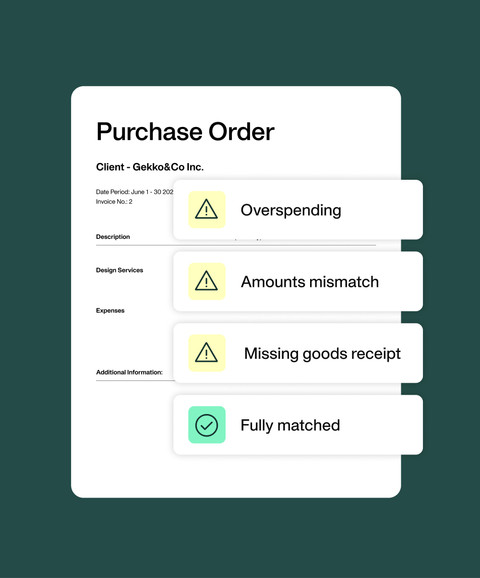
Changes to the GAAP: What UK businesses need to know



With significant changes to the GAAP FRS 102 on the horizon — the accounting standard that applies to smaller entities in the UK and Ireland — it’s time to get prepared.
By submitting this form, you agree to receive emails about our products and services per our Privacy Policy.
These changes to the GAAP are being introduced to align more closely with international standards and to improve the quality and clarity of financial reporting. This blog provides an overview of the key changes and offers practical advice on how businesses can prepare; with thanks to accounting rockstar and VEDA Accounting Founder Maggie Stancheva, for her top-notch advice and insights.
Pre-approve spending and streamline procure-to-pay

Why is FRS 102 Changing?
As the accounting landscape evolves, the Financial Reporting Council (FRC) has recognised the need to keep accounting standards relevant and effective. This is achieved through the Financial Reporting Exposure Draft (FRED) system, which allows stakeholders to comment on proposed changes.
The most recent drafts, FRED 82 and FRED 83, introduce several key updates to FRS 102. The comment periods for these drafts have closed, and the FRC is currently reviewing the feedback received from accounting bodies and firms. These changes, expected to be effective from January 1, 2025, aim to bring FRS 102 closer in line with International Financial Reporting Standards (IFRS), particularly those relevant to SMEs.
Maggie says:
The recent amendments to FRS 102, introducing significant changes in lease accounting and revenue recognition, represent a substantial shift towards aligning with IFRS standards. These modifications promise to enhance transparency and consistency in financial reporting, which is crucial for all businesses, particularly startups and SMEs navigating the complexities of financial disclosures.
Key changes to IFRS 15
One of the most significant changes introduced by FRED 82 is the alignment of FRS 102 with IFRS 15, which deals with revenue from contracts with customers. This change is crucial as it introduces a new five-step model for revenue recognition, which will impact how companies report their income.
The five-step model for revenue recognition
- Identify the contracts with a customer: The contract must have commercial substance, and both parties must be committed
- Identify the promises in the contract: Determine the specific obligations and any implied promises
- Determine the transaction price: Consider whether the price is fixed or variable, and account for any refund liabilities
- Allocate the transaction price to the promises: Split the transaction price among different obligations if necessary
- Recognise revenue: Revenue should be recognised when the entity satisfies a promise, either at a point in time or over time
This model provides a structured approach to revenue recognition, ensuring consistency and comparability across industries. However, businesses must assess the impact of these changes on their current contracts and financial reporting practices.
Maggie says:
Regarding the new revenue recognition standards, the shift to a five-step model aims to simplify the process but requires a deep dive into contract specifics. This can particularly affect how and when revenue is recognised, potentially altering the timing of revenue reported in the financial statements. For businesses, this means revisiting contract terms and possibly restructuring them to align with the new model, ensuring revenue is recognised at appropriate times to reflect true business performance.
IFRS 16: What's new?
Another critical update relates to lease accounting under IFRS 16. This standard, which significantly changes how leases are reported, will now apply to entities using FRS 102.
The challenges of IFRS 16
Under the new standard, all leases must be recognised on the balance sheet. This includes leases that were previously classified as operating leases and reported as off-balance-sheet items. The change aims to improve transparency but introduces several challenges, particularly for smaller entities.
- Data collection: Companies must review all lease contracts and gather comprehensive data, including lease terms, renewal options, and variable payments
- Discount rates: Lessees must discount lease payments using the rate implicit in the lease or, if that rate is not available, the incremental borrowing rate. This requires careful judgment and can impact financial metrics
- Financial statement presentation: All leases will now be recognised on the balance sheet, affecting key financial ratios and profitability metrics. Companies must understand how this will impact their financial performance
- Ongoing monitoring: Changes in lease terms or modifications can significantly impact the recognition and measurement of lease assets and liabilities. Companies must have processes in place to monitor and update lease agreements regularly
Maggie says:
The alteration in lease accounting, which requires nearly all leases to be reported on the balance sheet, is a significant shift. This will inevitably increase the gross assets and liabilities reported by businesses, impacting several key financial metrics. Most notably, EBITDA (Earnings Before Interest, Taxes, Depreciation, and Amortisation) will likely see an increase as operating lease expenses previously recorded in the income statement move to depreciation and interest expenses on the balance sheet. While this might improve EBITDA, a commonly tracked performance metric, it could also lead to increased financial leverage ratios, affecting how investors and lenders evaluate the financial health of a business.
Some good news for SMEs
There is some relief for smaller entities under FRS 102. For leases with terms of 12 months or less or involving low-value assets, companies can opt to treat these as expenses on a straight-line basis. Additionally, the use of the gilt rate for discounting purposes provides an accessible and publicly available rate, simplifying the calculation process.
Updates to FRS 102 Section 1A
FRED 82 introduces changes to FRS 102 Section 1A, too, particularly relevant for smaller entities. These updates aim to make the standard more accessible and relevant to SMEs.
New sections and clarifications
- New Section 23: This section incorporates the IFRS 15 five-step model for revenue recognition, tailored with simplifications for smaller entities
- New Section 20: This focuses on accounting based on the IFRS 16 Leases on-balance-sheet model, also with simplifications for smaller entities
- New Section 2A: The appendix on fair value measurement, previously part of Section 2, is now given a more prominent place as Section 2A in the proposed standard
Additionally, FRED 83 proposes changes to FRS 101 and FRS 102 to align with OECD Pillar 2 rules for international tax. These changes introduce temporary exceptions for deferred tax and reporting requirements for smaller entities.
Your next steps
Given the scope of these changes, it's essential for businesses to start preparing now. Here’s what you should do:
- Engage with your auditor: Discuss the implications of the new reporting changes with your auditor. They can help you understand the impact on your financial statements and what adjustments may be needed
- Assess the impact: Evaluate how the changes to IFRS 15 and IFRS 16 will affect your current contracts, leases, and financial reporting practices. Identify areas that require adjustments and plan accordingly
- Update systems and processes: Ensure that your accounting systems can capture the necessary data for compliance with the new standards. This may involve upgrading your systems or implementing new processes
- Train your team: Provide education and training to your finance team and relevant stakeholders to familiarise them with the new requirements and their implications
- Review contracts and leases: Review existing contracts and leases to identify any modifications or specific terms that may impact revenue recognition and lease accounting under the new standards
- Plan for disclosures: Develop a robust system for gathering and reporting the required disclosures under IFRS 15 and IFRS 16. Ensure that this information is captured accurately for transparent and informative financial reporting
Maggie says:
These shifts underscore a fundamental transformation in how leases are accounted for and reported. Businesses must now take a proactive approach in reviewing their lease agreements and financial reporting processes. It will be crucial to communicate with financial stakeholders — investors, lenders, and auditors — to ensure they understand the reasons behind the changes in financial metrics and how these reflect the company's actual economic circumstances rather than a deterioration in performance.
Summary: Early preparation is essential
The upcoming changes are designed to bring UK GAAP closer to international standards, enhancing the transparency and comparability of financial reporting. However, these changes also introduce new challenges, particularly for smaller entities.
By starting to prepare now, businesses can ensure a smooth transition to the new standards and avoid any last-minute compliance issues. This includes engaging with auditors, reviewing contracts and leases, and updating systems and processes to capture the necessary data. Early preparation will not only ensure compliance but also position your business for success in an evolving regulatory landscape.
Maggie says:
Overall, while these updates aim to bring UK GAAP closer to global standards, enhancing comparability and reliability of financial information, they also require businesses to make significant adjustments. The transition might be challenging, but with the right guidance and adjustments, businesses can use these changes to their advantage, showcasing stronger and more transparent financials to stakeholders and potential investors.
If you're looking to streamline your accounting processes and ensure compliance with the new standards, consider investing in smart spend management software that integrates seamlessly with your ERP system.
Book a demo today to learn more about how we can help you navigate these changes with ease.
Trish Toovey works across the UK and US markets to craft content at Payhawk. Covering anything from ad copy to video scripting, Trish leans on a super varied background in copy and content creation for the finance, fashion, and travel industries.
Related Articles


Practical spend management guide for mid-market CFOs and finance leaders

